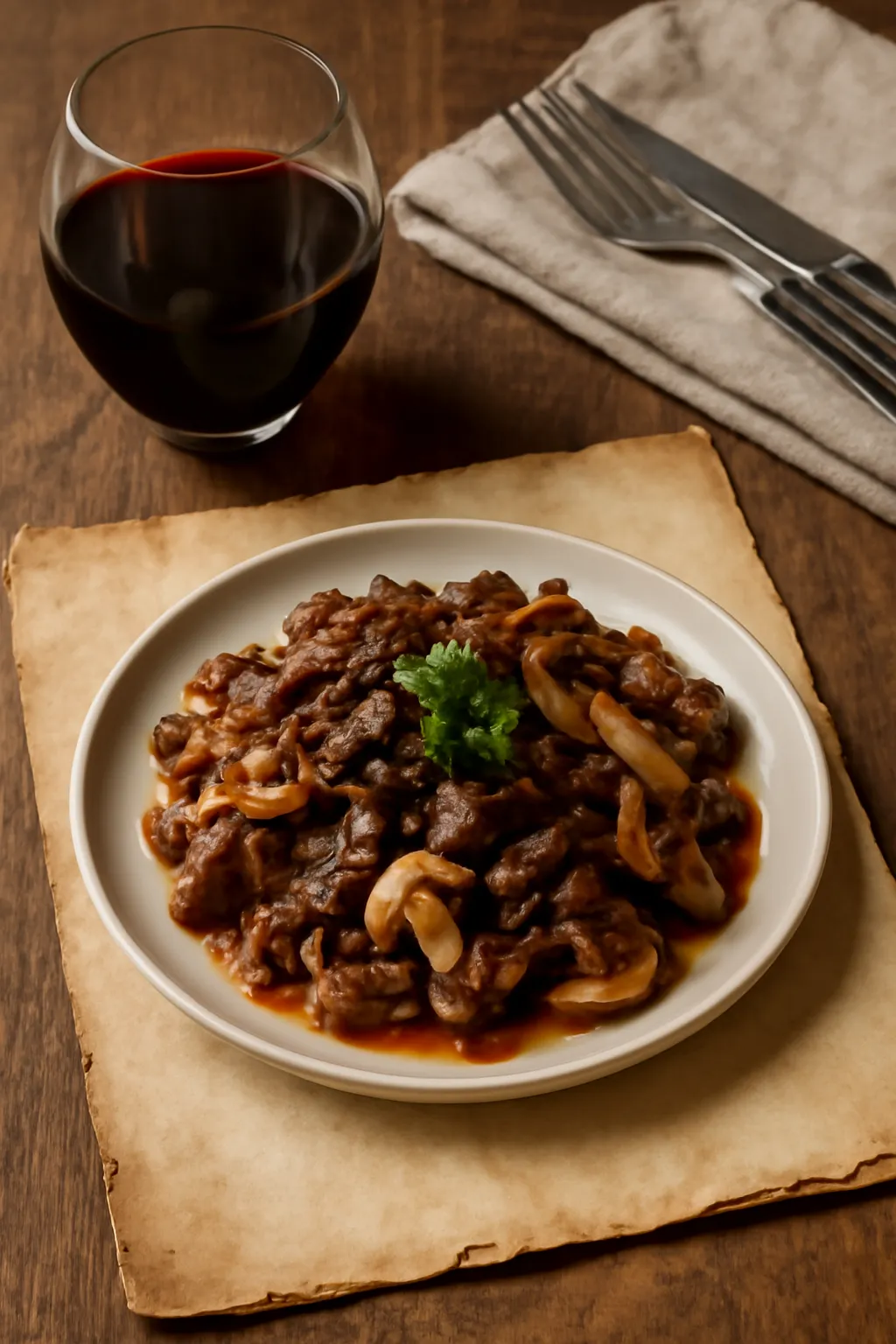Have you ever wondered how red wine can transform a simple meal into a gourmet experience? Or how a savory bulgogi dish can take on new depth with earthy mushrooms and the richness of a fine vintage? In this article, we’ll explore the captivating harmony of red wine mushroom bulgogi—served atop a piece of nostalgic old paper for that rustic flair. This is more than just cooking; it’s an edible journey through flavor, history, and sensory delight.
Red wine: A Heritage of Flavor and Depth
Red wine isn’t just a drink—it’s a tradition, a ritual, and an essential ingredient that adds complexity to cooking. Made from dark-skinned grape varieties, red wine has been around for thousands of years, revered by ancient civilizations from Mesopotamia to Rome. Its flavor profile—ranging from light and fruity to full-bodied and tannic—makes it versatile for pairing and cooking alike.
When used in culinary settings, red wine does more than moisten and tenderize. It enhances the flavor of meats, deepens sauces, and binds ingredients in ways that water or broth simply can’t. Personally, I’ve noticed that using even a half-cup of Merlot or Cabernet Sauvignon in stews and marinades brings out an unmistakable richness.
Here are five reasons red wine elevates cooking:
-
Acidity balance – Cuts through fatty meats.
-
Tannin structure – Adds mouthfeel and complexity.
-
Fruit notes – Pairs with sweet elements like onions and carrots.
-
Alcohol content – Helps dissolve fats and aromatics.
-
Caramelization – Intensifies browning in meats and vegetables.
For example, I once made a beef bourguignon with a modest bottle of Côtes du Rhône, and the resulting sauce was so flavorful that even my wine-averse friend asked for seconds. That’s the magic of red wine—it harmonizes with both rustic and refined cuisine.
For those curious about integrating red wine into their home cooking, start with dishes that require simmering: beef stew, coq au vin, or pasta with wine-reduced sauces. You’ll discover that wine isn’t just something to sip—it’s something to savor in every bite.
더욱 자세히 알아보려면 아래 버튼을 클릭하세요.
👉”Red Wine Flavor Profile Guide”👈
Red wine mushroom: Earthy Elegance in Every Bite
Combining mushrooms with red wine is a stroke of culinary genius. Both are rich, earthy, and brimming with umami, yet each offers something unique. Mushrooms bring texture and forest-floor aroma, while red wine infuses them with acidity and depth. Together, they create a layered, luxurious taste that elevates any dish they touch.
In my kitchen, I like to start by sautéing shiitake or oyster mushrooms in butter until golden, then deglazing the pan with red wine and a touch of soy sauce. The scent is incredible—woodsy, sweet, and savory all at once. This method became the foundation for one of my favorite recipes: Red Wine Mushroom Bulgogi.
Here’s what makes red wine mushrooms exceptional in cooking:
-
Textural variety From chewy enoki to juicy portobello.
-
Umami synergy Enhances meatiness without adding meat.
-
Alcohol absorption Soaks in wine’s tannins for bold flavor.
-
Versatility Works in pasta, stir-fry, stews, and risottos.
Take, for instance, the first time I served red wine mushrooms with Korean bulgogi. The savory-sweet beef marinade welcomed the wine reduction like an old friend. A touch of garlic and sesame oil added harmony, while the mushrooms soaked up the juices like tiny flavor sponges. It was a dish that looked humble but tasted gourmet.
Pro tip: Always cook down the wine when making mushrooms. The alcohol needs to evaporate to avoid bitterness, leaving behind a concentrated flavor bomb that enhances the fungi’s earthiness.
더욱 자세히 알아보려면 아래 버튼을 클릭하세요.
Cooking with red wine: A Kitchen Alchemy
Cooking with red wine isn’t as daunting as it sounds. In fact, it’s one of the simplest ways to make your meals more elegant and flavorful. From marinades to reductions, and from pan sauces to slow roasts, red wine brings an unmistakable gourmet touch.
The key is knowing when, where, and how to use it. For instance, never use cooking wine—its high salt content and poor quality ruin more dishes than it saves. Instead, use wines you’d happily drink. As a rule of thumb, the better the wine, the better the sauce.
Here are seven dishes where red wine makes a big difference:
-
Beef or mushroom bourguignon
-
Osso buco with red wine reduction
-
Red wine poached pears
-
Braised short ribs
-
Marinated lamb chops
-
Red wine risotto
-
Korean bulgogi with red wine mushrooms
For example, I’ve adapted traditional bulgogi by substituting part of the sugar in the marinade with a fruity red wine reduction. The result? A deeper, rounder sweetness that lingers on the palate. The mushrooms, pre-seared and braised in wine, add that rustic French bistro touch to an otherwise Korean classic.
When cooking, add wine early to let the alcohol evaporate and flavors develop. Finish the dish with a splash of wine if you want a bright, acidic punch. In both Western and Eastern recipes, this approach works wonders.
Another memorable experiment was a red wine glaze on grilled mushrooms served over bulgogi lettuce wraps. Topped with sesame seeds and green onion, it looked like street food but tasted like fine dining.
더욱 자세히 알아보려면 아래 버튼을 클릭하세요.
👉”Explore Red Wine Cooking Recipes”👈
Conclusion
Red wine mushroom bulgogi may sound like a culinary experiment, but it’s grounded in timeless traditions and bold flavors. We explored the deep heritage of red wine, the earthy elegance of mushrooms, and how cooking with wine can unlock an entirely new realm of taste.
As Julia Child once said, “I enjoy cooking with wine. Sometimes I even put it in the food.” Whether you’re enhancing a simple weeknight meal or preparing a special dinner, red wine has the power to turn ordinary into extraordinary. So dust off that old paper recipe card—or better yet, create a new one—and start your own flavorful journey.






